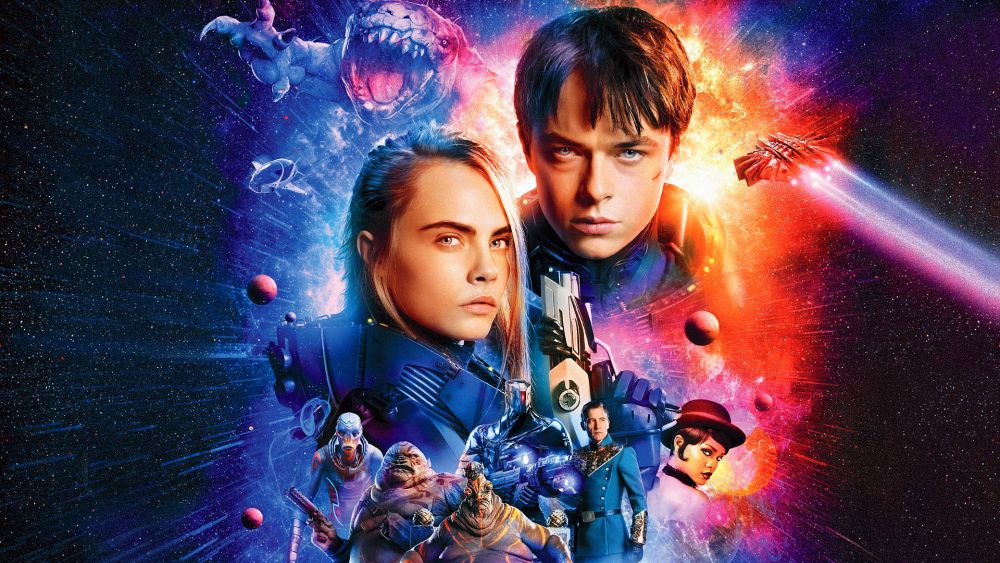As much as Hollywood has come to fall in love with adapting comic books into feature films over the past couple of decades especially, one particular staple of comics, at least in French culture, has taken a strangely long time to reach the big screen. I’m of course referring to beloved French comic book series, Valerian and Laureline, a sci-fi/adventure saga originally told through the printed panels, which allegedly inspired several design elements of Star Wars, but most definitely had a big influence on French filmmaker, Luc Besson. This influence is seen all over Besson’s cult 1997 sci-fi flick, The Fifth Element most notably, which has a similar blend of tongue-in-cheek futurism, larger-than-life cosmic fantasy, and swashbuckling romance.
With The Fifth Element observing its 20th anniversary in 2017 then, it seems that Besson decided that it was finally time to do a straight-up film adaptation of Valerian and Laureline, which manifested as Valerian and the City of a Thousand Planets. This is a huge passion project for Besson, who has enjoyed a lot of success throughout his robust writing, producing and directing career even to this day, especially with recent smash hits like the Taken trilogy, and the enormously profitable sci-fi thriller, Lucy. These successes appear to have given Besson enough capital to realize his vision for a blockbuster-worthy cinematic adaptation of Valerian and Laureline, which now holds the record for being the most expensive independent movie ever made, as well as the most expensive European movie ever made.
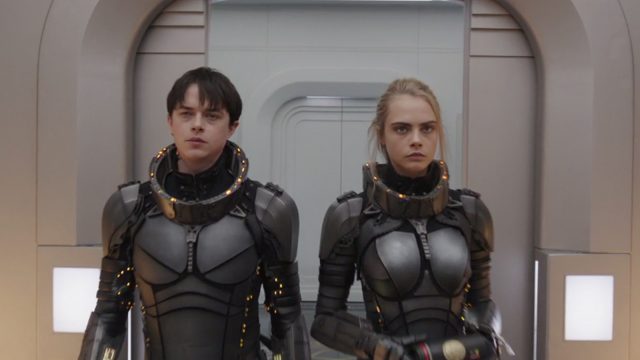
That’s why it’s legitimately heartbreaking that audiences at large ended up turning their noses at Valerian and the City of a Thousand Planets, which is now unfortunately one of 2017’s biggest box office flops, not even making back half its budget after two whole weekends in theatres. Something about this movie just failed to connect with mainstream audiences, and having now seen it myself, I believe that part of the problem is that this is a beautiful adaptation of Valerian and Laureline, but one that’s also strangely lacking in real thrills or focus. If you enjoy visually arresting movies however, then you should nonetheless absolutely check out Valerian and the City of a Thousand Planets on the big screen, where it’s clearly meant to be enjoyed most. This movie is at least wonderful to look at, even if it ultimately can’t compete with many of the beloved sci-fi movies that its source comics went on to inspire.
Valerian and the City of a Thousand Planets stars Dane DeHaan as the title character, Valerian, a cocky major who is partnered with no-nonsense sergeant, Laureline, played by Cara Delevingne. These are supposed to be two light-hearted characters who get into a variety of mischievous, troublesome situations, much to the chagrin of their military superiors. If you’re familiar with DeHaan’s and Delevingne’s body of cinematic work to date though, you may be able to anticipate a problem early on with this direction; Both DeHaan and Delevingne are quite clearly miscast in these roles.
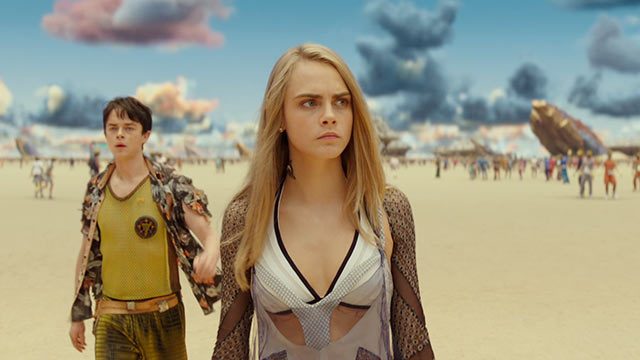
These are two very intense actors trying to play two vaguely comical heroes with a metric ton of sexual tension, and while intense actors can sometimes fit into a comedic role unexpectedly well when the direction is right (Ryan Gosling and Russell Crowe in last year’s outstanding The Nice Guys is a great example), it just really doesn’t work here. DeHaan looks far too broody and serious to believably play an arrogant, yet playful spacefaring hero, while Delevingne fares a bit better as the more straight-laced Laureline, but even she clearly struggles with the playfulness of the written material. This movie tries so very hard to inject personality into these two heroes, but it never fully registers. They manage an amusing interaction every now and again, but for the most part, they’re disappointingly boring, despite the script’s clear efforts to give them action and fun to work with. Worse still is that these two just don’t have good chemistry, which makes a lot of the humour and adventure elements fall flat on their faces, contributing to the feeling that Valerian and the City of a Thousand Planets is significantly more dull than it should be at times.
Even worse is that there’s barely anything to say about the huge cast of supporting characters too, which include performances from actors like John Goodman and Elizabeth Debicki, among others, who are often hidden under a ton of alien CGI. Valerian and the City of a Thousand Planets is full of exotic aliens and characters who talk like they’re supposed to be important, but no one in this odyssey truly does feel important or memorable in the end. They all just serve their thin roles in the ultimately unmemorable, and yet overstuffed plot, and there’s really nothing more to say.
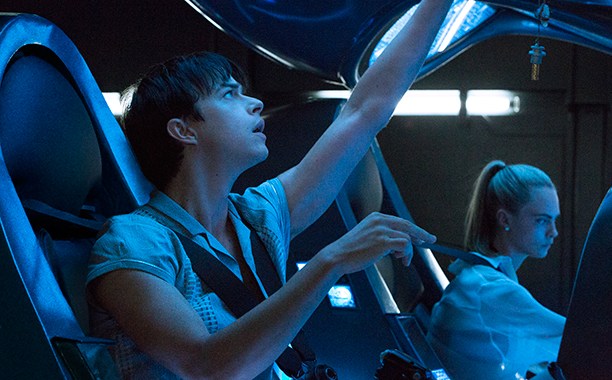
In fact, it’s quite a strange situation for the performances when the most memorable and heartfelt character in the movie is portrayed by Rihanna of all people! Rihanna’s shapeshifting alien dancer, Bubble, along with her obnoxious pimp, Jolly, played by Ethan Hawke, are the two characters that make the biggest impression, because they’re the two characters that actually do capture the fun and adventurous spirit of both the source comics, and Besson’s clear inspiration of trying to replicate his cult success with The Fifth Element here. It’s enough to make you wish that the movie was about Bubble and Jolly instead, but no such luck, especially when their roles don’t manage to expand beyond being a quick way to move the plot forward around the halfway mark.
As much as the shallow characters and problematic performances can be an issue in Valerian and the City of a Thousand Planets, by far the biggest problem with the movie is the fact that the large-scale storyline just doesn’t really come together that effectively in the end. This is the most obvious place where Besson is clearly trying to replicate the accidental genius behind the insane plot of The Fifth Element, but now that he’s making an adaptation of a beloved comic book, rather than doing an original film pitch that he came up with as a teenager, it feels like Valerian and the City of a Thousand Planets instead ends up bogged down with an ‘everything and the kitchen sink’ approach, which makes the story feel too bloated, inconsistent and unfocused.
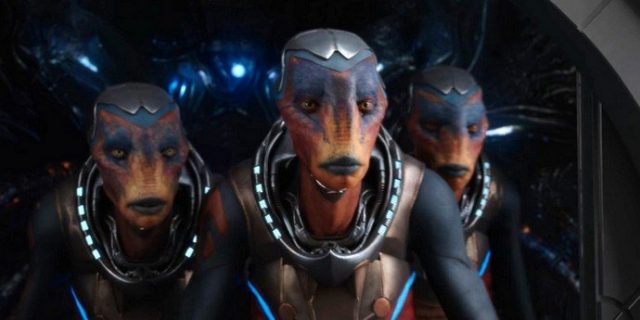
The simplest way to describe Valerian and the City of a Thousand Planets from a story standpoint then is that it’s, frankly, a complete mess. It has a lot of really cool ideas, but it just feels too scattered, and ultimately lacks a true sense of urgency or stakes, despite all of its efforts to provide excitement. The ultimate villain behind the piece has a decent twist behind them, but they sadly give way to a lacklustre climax that quickly fizzles out before it can truly get going, leading to a messy sci-fi story ultimately ending on a disappointingly underwhelming note. There’s clearly a lot of neat lore behind the world of Valerian and the City of a Thousand Planets, but it truly feels like said lore is best left enjoyed in the series of comic books that inspired this movie, rather than the movie itself.
Luc Besson has proven numerous times to be a very talented director, having helmed several cinematic hits in the past, and that’s not even considering his lengthy resume of writing and producing work. While Besson is often best associated with movies he helped create but didn’t actually direct, such as the Taken series, the Transporter series and the Taxi series, he did however deliver a big contribution to the cult sci-fi film scene with his directing work on The Fifth Element. Valerian and the City of a Thousand Planets feels very much like the spiritual successor to The Fifth Element, being another risky sci-fi passion project for Besson. As much as Besson’s direction is still pretty great in several spots however, he often falls into a sort of ‘George Lucas Syndrome’ with his own script here, whereupon he seems more concerned with building the movie’s world, rather than properly realizing the personalities that inhabit it, which are supposed to serve as the audience’s true link to a fictional world that they can never truly relate to.
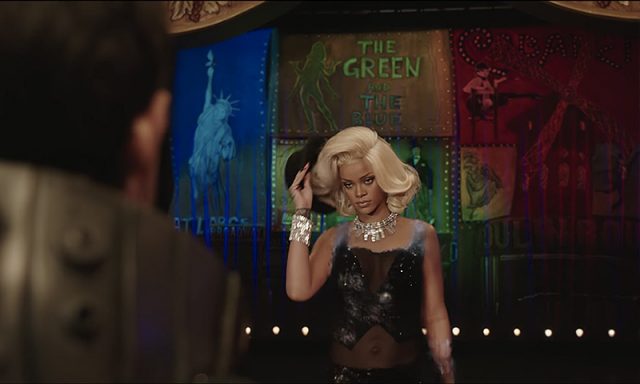
On the bright side, Besson’s imaginative direction is positively stunning when it works, and in any world-building scene especially, it always works. Besson has clearly given a lot of thought to the movie’s major set pieces, which at least manage to consistently surprise and delight the audience, even when the story and characters don’t quite manage the same result. There are pockets of enchantment and charm in Valerian and the City of a Thousand Planets, but the heart feels like it’s primarily in the window dressing. Thus, this spectacular, immersive movie ends up being hamstrung by its disappointing lack of personality, despite the fact that its world is consistently captivating. This is a frustrating struggle for Valerian and the City of a Thousand Planets, especially when it seems to run out of gas towards its third act, having exhausted many of its best ideas for action and adventure over the course of the proceeding hour and a half or so.
Alexandre Desplat composes the score to Valerian and the City of a Thousand Planets, which does its best to inject a sense of high adventure into the movie. There are quite a few likable compositions in the movie’s music, which does manage to create a charming, yet epic-sounding sci-fi movie score, making the music suite one of the better elements of Valerian and the City of a Thousand Planets for sure. This makes sense when you consider that the presentation is definitely the strongest part of this movie, and it seems evident that Desplat also wanted to play to the movie’s strengths, namely by bolstering its world, rather than the characters that the script and casting seem to have routinely failed.
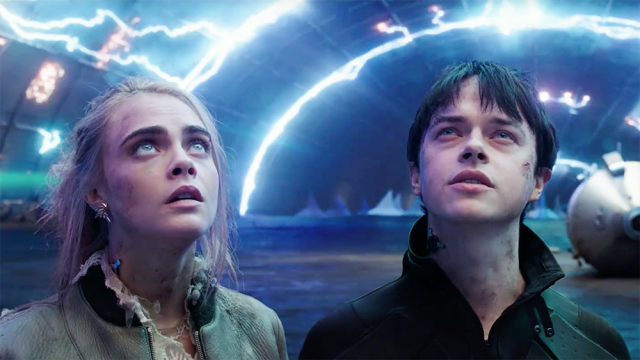
The rest of the audio work also seems to echo the spirit of making a more fun and light-hearted sci-fi world, though not one that is without drama or excitement. There’s sort of a retro charm to the audio effects and sound mixing throughout Valerian and the City of a Thousand Planets, and one that definitely calls back to The Fifth Element, as well as, to a lesser extent, the original Star Wars movie trilogy. This world is not meant to feel particularly real, and that’s fine, since its audio presentation helps to stir the imagination and take us back to a simpler, more light-hearted era of sci-fi.
Here we come to easily the most consistently strong and outstanding element of Valerian and the City of a Thousand Planets, that being the visual presentation. This movie earns its lofty record of being the most expensive European movie and most expensive independent movie made to date, since it looks absolutely stunning to behold, even when the story is at its most messy and sluggish. The world of Valerian and the City of a Thousand Planets constantly leaps to life with incredible vibrancy and energy, and the alien creature designs are especially outstanding, even rivaling the juggernauts of Star Wars and Star Trek in terms of being distinct and imaginative! The technology that the characters use is also often quite neat, with some standout action scenes involving crashing through multiple diverse environments in an enormous space station, while another great action moment has the characters moving between dimensional spaces on a particularly risky mission.
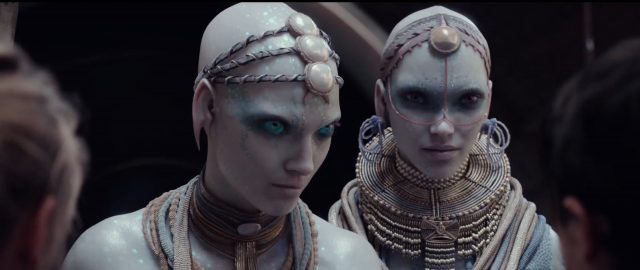
There’s clearly a great effort thrown behind not just the raw beauty and colourful nature of the visuals behind Valerian and the City of a Thousand Planets, but also in a sense of tapping upon a world that has many years of rich history and lore, even if we sadly don’t see most of this potential realized. This brings me to the movie’s 3D presentation, which is fairly decent, though isn’t strictly necessary to enjoy the visuals on display. Seeing Valerian and the City of a Thousand Planets in 3D does add a slight bit of expanded immersion, especially in the spacefaring shots, but it doesn’t contribute much to the action scenes, nor does it manage to do a whole lot with the already strong atmosphere. In this case, seeing Valerian and the City of a Thousand Planets in 3D or 2D, assuming you have the option, will likely come down to a matter of your personal preference, since the 3D work is satisfactory, but you also don’t lose much if you choose to skip that, and just watch the movie flat in 2D.
Valerian and the City of a Thousand Planets sadly ends up being a frustrating disappointment, though not for lack of trying. The real tragedy behind the movie is that there’s clearly been tons of effort put into it from all involved, especially from writer-producer-director, Luc Besson, who clearly has a deep love and appreciation for the original Valerian and Laureline comic books. Sadly though, this is a movie that just didn’t end up working out as well as it should have, since the characters and storyline just aren’t good enough to provide a truly meaty or worthwhile cinematic experience on their own.
With that said however, the stunning presentation behind Valerian and the City of a Thousand Planets is nonetheless best experienced on the big screen, so if you happen to enjoy visually outstanding movies, you should nonetheless go and see this while it’s still in theatres. It’s quite possible that Valerian and the City of a Thousand Planets could at least develop a cult following akin to Besson’s sci-fi darling, The Fifth Element, though I think it’s also difficult to argue with The Fifth Element being the stronger movie, since that movie isn’t beholden to decades of source comics, and is simply allowed to thrive on being Besson’s own brainchild.
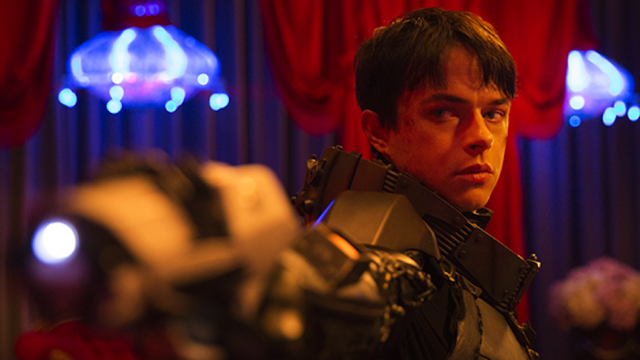
Valerian and the City of a Thousand Planets is certainly not without merit, but sadly, it does end up being another disappointment in a Summer blockbuster season that has had just way too many disappointments for 2017. The fact that this lacklustre Summer movie season, which has been virtually entirely upheld on standout superhero blockbusters before this month, finally seemed to be picking up between the masterful one-two punch of War for the Planet of the Apes and Dunkirk, also adds insult to injury for Valerian and the City of a Thousand Planets. If Besson was hoping to turn this into a franchise, it certainly doesn’t seem like that’s going to happen now. Nonetheless, if Valerian and the City of a Thousand Planets can find its own cult audience just like The Fifth Element did, I suppose it’s also true that this bold adaptation nonetheless can’t be written off as a true failure.

